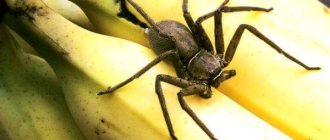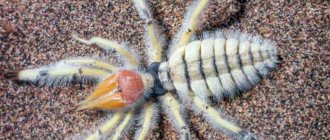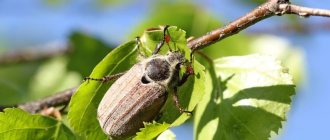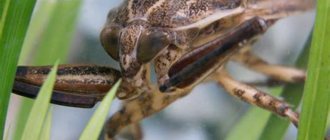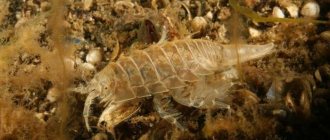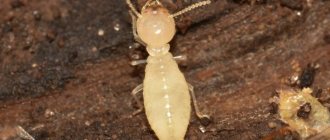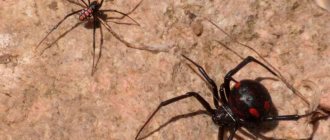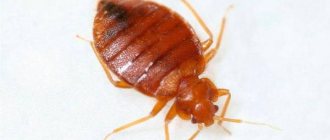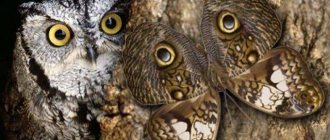Of all the numerous varieties of arachnids, only one species chose bodies of water to live. This is a silverback spider, also known as a water spider. This amazing animal has an appearance characteristic of all its relatives, and living conditions that are completely different from other arachnids. The silverfish cannot be called a completely underwater inhabitant - the spider can also be on the surface of reservoirs, and breathes air even in water.
- Classification and habitat
- Behavior in the wild Nest
- Types of domes
- Reproduction
- Wintering
- Hydrachna cruenta Mull
- Small crustaceans
Classification and habitat
The Latin name of the spider is Argyroneta aquatica. Belongs to the family Cybaeidae (cybeids).
Silverfish live across most of the Eurasian continent - from the islands of Britain to Japan. In Russia and Europe they are common in most regions. The water spider inhabits bodies of water with stagnant water, and occasionally chooses rivulets and streams with weak currents for habitat.
.
In the reservoirs where the silver spider lives and breeds, there should be abundant vegetation, a lot of algae, on which it builds webs for catching prey and breeding offspring.
The Latin and Russian versions of the name of the water spider contain the root “silver”.
Being in water surrounded by air, the animal’s body shines with a silver sheen, so in different languages it is called in accordance with this quality.
Where does the Brazilian wandering spider live?
Photo: Dangerous Brazilian wandering spider
The main habitat of this species is America. Moreover, most often these arthropods are found in the tropical forests of Central and South America. Representatives of this species can also be found in Brazil and northern Argentina, Venezuela, Peru and Havana.
Spiders are thermophilic; the main habitat of these arthropods is the tropics and jungle. There they are placed on the crowns of trees. Spiders do not build shelters or burrows for themselves; they constantly move from one habitat to another in search of food.
In Brazil, spiders of this species live everywhere, perhaps only in the northern part of the country. Both in Brazil and in America, spiders can crawl into houses, which terribly scare the local population.
They love warm and humid tropical climates. Spiders of this species do not live in Russia due to the climate. However, they can be found accidentally brought from warm countries in boxes with tropical fruits, or by spider lovers for breeding them in a terrarium.
In recent years, this dangerous animal is increasingly being kept at home as pets. At home, they can live all over the world, but keeping them is not recommended due to the extreme danger of this species. Spiders also don’t live well in captivity, so you need to think carefully before getting such a pet.
Now you know where the Brazilian wandering spider lives. Let's see what he eats.
Behavior in the wild
If, according to the description, the silverfish can be confused with other species of the arachnid class, then the way of life is fundamentally different. The dropsy is the only spider that lives well in water. Swimming functions are provided by the legs, which he uses to row like oars.
The silverfish cannot be considered an absolutely underwater spider - it runs perfectly on land. At the slightest danger, an animal pulled to the surface by a net develops an enviable speed.
Dropsy can be detected and identified by the air bubble (bell), in which it sits shallow under water, sticking out halfway, and awaits a gaping victim.
The construction and maintenance of an underwater house is the main part of the silverfish’s life, a condition for its successful hunting.
Nest
The construction of the nest takes place in several stages:
- First, the silverfish chooses a convenient place for hunting - it hangs a loose web on underwater plants. Cobwebs are a product of special glands that are found in all arachnids. This sticky substance comes out liquid, but quickly hardens in air and water.
- Having weaved a network, the dropsy begins to draw air from the surface. It comes to the surface and captures air bubbles with the hairs on the body. Releases it under the arachnoid membrane, lifting it.
- The arachnoid network plays the role of the shell of a balloon. As the spider captures a new portion of air, it strengthens the surface with new layers of web. The atmospheric air captured by the hairs is what the silverback spider gradually fills the nest with.
- The air lifts the constructed dome, creating a comfortable nest the size of a walnut inside it.
One end of the shelter is open and serves as the entrance to the underwater house. The silverfish rests in its home, cleans its hairs, waits for prey, eats, and hangs up prey left for future use.
The spider lives alone in the nest; the males build houses close to the females, but live separately.
The dome has to be filled with air regularly. Healthy, strong individuals have large nests. Sick and weakened silverfish lose the ability to hold air on their body, the nest falls apart, becomes small and loose. The spiders weaken and drown.
Types of domes
For different life processes, water spiders build special nests:
- Summer. Most of the silverfish's active life takes place in these shelters.
- Egg. Typically, females convert their homes into egg domes when they lay eggs.
- For molting. Here the spiders wait out the period of changing their body shell.
- Wintering. This shelter is intended for hibernation - the shell is dense, the size is smaller. However, silverback spiders more often use shells for wintering. They skillfully adapt to conditions and occupy empty mollusk houses.
- Spermic. Males build in preparation for reproduction.
Building a nest takes several hours. During this time, the silverfish rises to the surface several dozen times, stops to rest and continues working until complete completion.
Reproduction
The male looks for a female and fertilizes on her territory - in her summer home. She looks after the offspring. The clutch contains from 15 to 160 eggs. The female regularly fills the bell with air and protects the clutch.
Egg development lasts 10 days. The little spiders molt twice in their mother's house, then leave the house and live on their own.
Family ties are severed after leaving the nest. A hungry female can eat gaping spiders from her own offspring that have left the house.
Wintering
Silverfish can overwinter at any stage of development. Late clutches wait out the winter in the mother's nest. Vernal ponds are usually full of young silver spiders.
Aquatic plants falling to the bottom in autumn pull nests with spiders down. There they spend the winter. In spring they float closer to the surface. Some spend the winter on the shore in shells. With the onset of warm weather, they thaw safely if they are not eaten by birds.
Spring waters spread dropsy over a large area. They migrate in mollusk shells and directly in domes.
UNDER-ICE BATHYSCAPH
Silverfish overwinter in a special, especially durable air dome. Sometimes they even use pond snail shells for this. Having carried a supply of air there and attached the shell to duckweed floating on the surface of the water, the spider seals the entrance and falls into a state of deep rest. During the winter, the duckweed drowns, taking the shell with it, and in the spring, when the water warms up, it floats up again. Now the overwintered spider can leave its winter apartment.
https://www.youtube.com/watch?v=ytaboutru
Young spiders and males spend the winter most of the time; females are less numerous. Sometimes late egg cocoons overwinter together with the females.
Body size and structure
The appearance of dropsy is quite classic - the body consists of two parts. There is a deep section between the cephalothorax and abdomen.
The body of young spiders is lighter in color (yellow-brown, greenish-gray) than that of adults and old ones.
Body structure features:
- The cephalothorax is rounded, the head is convex, slightly narrowed.
- There are 8 pairs of eyes, despite this vision is weak; even a few centimeters away, the silver spider cannot distinguish objects.
- There are 2 pairs of jaws on the head, one of them has sharp edges (chelicerae) and a poisonous gland. With the help of the secretion of this gland, the spider immobilizes and kills prey.
- The legs have hairs with which the spider feels objects. They play the role of organs of touch.
- The scutellum is shaped like a heart; underneath it are the bases of 4 pairs of legs. In males, the front legs are longer than the hind legs.
- The abdomen is not dissected. The surface is covered with bristles or hairs. Their density is very high - about 1000 per square millimeter. These hairs have different shapes and lengths. They serve to hold air around the body.
The structure and arrangement of hairs in males and females is different.
The male has no hairs on part of his back. Because of this, the air dome of spiders is different; the female can be distinguished from the male by the shape of the bell around the body. Although most of the silver spider's life is spent in water, it breathes atmospheric air. Underwater existence is ensured by the construction of a cozy nest, similar to a vessel with air, and thin bristles that are not wetted by water.
Silverfish constantly rub their hairs with their paws, clearing them of impurities so that they retain air better. To do this, they suck their paws, secreting a special secretion that they use to treat the hairs on their body.
This is the main activity of the spider in the air dome when it is not waiting for prey.
The size of female silverfish is 11-12 millimeters, males – 14-18 millimeters. Female dropsy are small and not aggressive. They do not eat their males after fertilization, like other spiders. They get along well in the neighborhood - males usually build a house near the nests of females, so as not to spend a long time looking for a partner for reproduction.
How do they swim?
Almost all spiders are terrestrial predators; the silverback is a pleasant exception to the rule.
It's all about the unique anatomy. The abdomen, covered with hairs and special fat, has the ability to accumulate air bubbles. As a result, a kind of air cushion is formed between the body and the hairs. Due to this, the silverfish feels great under water. She needs to come up regularly to replenish her air. Fat is a secretion of spider glands that has changed in composition. There is a funny feature that allows you to distinguish the gender of the silverback spider. To do this, you need to look at the bubble around the body: the male’s upper abdomen is free of air. The female has a bubble around her entire body and swims upside down. Males often swim horizontally and use their legs as oars. The water spider is able to cover a distance of two centimeters in a minute. This is a decent distance for such a baby.
Varieties
The most common species in our country is Clubionafallax - dropsy, silverweed.
This species has perfectly adapted to life in shallow stagnant waters, building bell-shaped domes for itself and its offspring. Each dwelling is intended for a certain phase of life - molting, wintering, breeding.
Males are 2-3 millimeters larger than females, look identical in appearance, and have a slightly darker body color.
Hydrachna cruenta Mull
A small red spider of the genus Araneina, also called a mite. It feeds on larvae and small crustaceans. The body is round, the spider looks like a small ball with short legs.
Attaches eggs to the foliage of aquatic plants, braiding them with an adhesive solution.
Dolomedes
This species is a representative of surface spiders that run along the surface at high speed. They prefer the surface of the water to dry land; when in danger, they easily dive into the water. The body size of females reaches 22 millimeters, males are significantly smaller (13 millimeters).
It can live on the shore, where it drags caught prey and eats it. It may not make shelters; it simply hides in the thickets of grass.
Its lifestyle can be called semi-aquatic. Lives near ponds and swamps, loves wet areas of meadows, forest thickets, and penetrates gardens.
Dolomedes can feed on insects caught in the air, aquatic inhabitants - fry, crustaceans. It kills the victim very quickly, then savors the food for several hours.
What does it eat?
Like all representatives of arachnids, silverfish are predatory animals. They build traps that are located under water to catch prey. The web serves to catch small animals while the owner waits in the dome. By the vibrations of the webs, the silverfish determines the appearance of the victim.
Then the dropsy acts like all spiders - it injects poison, then saliva. Waits for the food to soften and has lunch. If there is no desire to eat, the prey is taken into the dome and hung in reserve in the web.
Dropsy's food consists of underwater and terrestrial small inhabitants. The female's prey is often her own children who leave the nest.
Small crustaceans
The silverfish spends most of its life in water. Small crustaceans are the spider’s usual diet. The most favorite types of food include water donkeys, small crustaceans measuring 1-2 millimeters in size.
Fry are also often caught in silverfish nets, which can reduce the population of some fish species.
Mosquitoes
Mosquito larvae and the insects themselves, which live in abundance near bodies of water, make up a significant part of the silverfish’s diet.
flies
Ubiquitous flies of various species and their larvae often end up in webs and become food for silver spiders.
Is there any benefit or danger to humans?
Each insect or animal brings certain benefits. Silverfish destroys larvae and adult insects. Mosquitoes, flies and other flying pests can become dinner for silverfish. They often eat weak or sick fry, helping to form natural selection. They are poisonous and this protects them from the appearance of natural enemies.
https://youtube.com/watch?v=MUniPHc5VmI
The silverfish rarely attacks first, since it does not have developed aggression. However, when threatened, it can bite hard. Despite the fact that the venom is not fatal to humans, the bite can cause a lot of trouble. The wound aches, the pain intensifies, and sometimes numbness appears. But after a few days, all pain disappears. Some species of water spider are on the verge of extinction and are listed in the Red Book, so there is no need to destroy them because of personal hostility.
